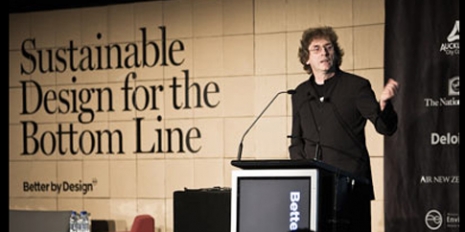
This year's CEO Summit set out to explore how New Zealand companies can make the most of sustainable design and business opportunities with examples given by several leading international organisations and a group of local companies committed to sustainability
This year’s CEO Summit set out to explore how New Zealand companies can make the most of sustainable design and business opportunities with examples given by several leading international organizations and a group of local companies committed to sustainability.
For a full outline of the Better By Design Conference please visit www.betterbydesign.org.nz
Key presentations were give by:
The most notable presentations given by local organizations were Jeremy Moon (CEO Icebreaker) and Brett Hewlett (CEO, Comvita).
Michael Braungart opened the presentations with an outline on cradle to cradle design. Much of his presentation was about the need to shift our mindset from 'eco-efficiency' to 'eco-effectiveness', which as he stated, is a "more positive business model".
A lot of the current thinking has revolved around the drive for 'zero waste' but as Michael outlined, when you think about zero waste you are still thinking about waste - which is really a guilt management scenario.
Much of the concept behind cradle to cradle is that products and materials need to be designed for either the biosphere (consumption products made from natural biological nutrients) or the technosphere (service products made from technical/manmade nutrients).
[Update: video from his talk is now available - see below.]
For more info visit: http://www.mbdc.com/ & http://www.braungart.com/
Ray Andersons took us on the amazing journey of transformation at Interface. In 1994 Ray and Interface embraced the concept of whole system design and developed the company into the largest commercial modular carpet manufacturer.
In his presentation Ray described sustainability as a "mountain to climb that’s higher than Everest" and that Interface has identified the seven faces of the mountain which are:
Ray mentioned that their quest to conquer this mountain started with three basic questions:
For more info visit http://www.interfaceinc.com/
Janine Benyus presented the practice of Biomimicry and the art of well adapted design. The core idea of Biomimicry is that 'nature is imaginative by necessity, and has already solved many of the problems we are grappling with'. Many of the case studies that Janine discussed related to the need for designers to get the biologist to the table and engage collaboratively to "put life at the centre of the decision making".
Basically our current heat, beat, treat process used in design and manufacturing does not reflect the way that nature would solve it and it needs to stop.
Janine along with a group of contributors has recnetly launched the Biomimicry website www.asknature.org which is a central source for looking for natural solutions to various design related problems.
For more info visit: http://www.biomimicryguild.com/ & http://www.biomimicryinstitute.org/
Lee Weinstein introduced us to the corporate responsibility practices being integrated at Nike where transparency, accountability and partnership is essential. Lee started with a very impresive video which inspired the audience and showcased some of Nike's achievements since it started.
Nike’s aim is “To bring innovation & inspiration to every athlete in the world”. The company’s environmental programme is referenced in part from the http://www.sustainability.com/. reporting framework. Here the company works within the five gears of the framework:
Lee indicated that Nike is now somewhere between 4th & 5th gear with a lot of work underway. Do check out the sustainability website for more information on the framework.